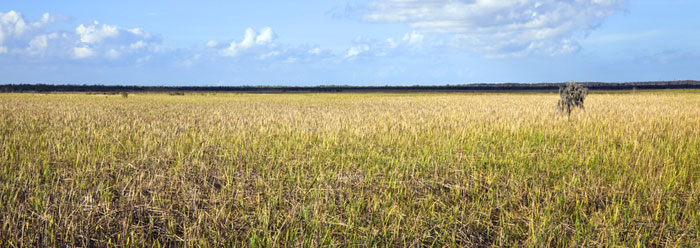Certain rock layers hold fossils of unique and extinct plants that had hollow tube-like structures, which probably made them lightweight and able to float on peat mats before they were buried and fossilized.1
A recent video from the United States Geological Survey featured scientists studying a giant modern floating marsh field in Louisiana.2 This unusual ecosystem can give a glimpse into the world as it might have been before Noah's Flood and can help explain a peculiar feature of the plant fossil record.
In the video, USGS researcher Chris Swarzenski noted that if the Louisiana fields were not regularly burned, trees would begin to grow and form a floating forest: "Over time, the marsh mat may thicken, becoming strong enough to support woody plants such as wax myrtle."2 But to account for the vast numbers of apparently floating plants now known from fossils, floating forests must have been as large as continents.
Truett-McConnell College paleontologist Kurt Wise proposed just such a model, having drawn inspiration from a visit to a quaking bog in Michigan. Other researchers have also written about the possibility of vast antediluvian floating forests extending into shallow seas from the margins of solid continents.3 Dr. Wise suggests that this explains the vertical order of plant fossils, with smaller, more fragile plant fossils found in layers below larger, woody plant fossils. Dr. Wise described the basics of his model in a 2008 issue of Answers magazine:
If a floating forest once existed, how did the plants get buried in the right order? I suspected that the destructive waves of the Flood ripped apart the floating forest from the outside in—first burying the weak water plants, then the small bushes, then the tall bushes, and finally the tall trees [in higher rock layers].4
Piecing together clues to reconstruct the past is an intriguing and ongoing endeavor. And the fact that vast floating fields exist today is another clue that pre-Flood floating forests were feasible.
References
- Kuntze, O. 1884. Phytogeogenesis: Die Vorweltliche Entwickelung der Erdkruste und der Pflanzen in Grundzugen. Leipzig, Germany: P. Frohberg. In Woolley, J. F. 2010. The origin of the Carboniferous coal measures—part 1: Lessons from history. Journal of Creation. 24 (3): 76-81.
- McKee, K. L. The Floating Marshes of Louisiana: A Unique Ecosystem. United States Geological Survey. Online video posted on usgs.gov, accessed February 1, 2012.
- Scheven, J. 1996. The Carboniferous floating forest—an extinct pre-Flood ecosystem. Journal of Creation (formerly Technical Journal). 10 (1): 70-81.
- Wise, K. P. 2008. Sinking a Floating Forest. Answers. 3 (4): 40-45.
* Mr. Thomas is Science Writer at the Institute for Creation Research.
Article posted on February 22, 2012.




